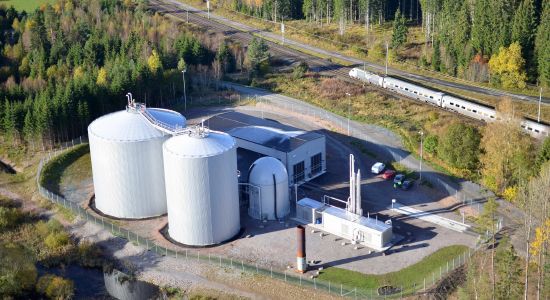From Waste to Energy: How Biogas is Revolutionizing Sustainability
Are you tired of seeing piles of organic waste being dumped into landfills, contributing to pollution and greenhouse gas emissions? Biogas may be the solution you've been looking for. Biogas is a renewable energy source that is created by breaking down organic matter, such as food waste, animal manure, and sewage, through a process called anaerobic digestion. In this article, we will explore the benefits of biogas and how it is revolutionizing sustainability.
What is Biogas?
Biogas is a mixture of methane, carbon dioxide, and other gases that are produced when organic matter is broken down in the absence of oxygen. This process, known as anaerobic digestion, is carried out by microorganisms that break down the organic matter and release gases as a byproduct. Biogas can be produced from a variety of organic waste sources, including agricultural waste, food waste, sewage, and municipal solid waste.
Biogas as a Renewable Energy Source
Biogas is considered a renewable energy source because it is produced from organic matter that can be replenished. Unlike fossil fuels, which take millions of years to form and are finite, biogas can be continuously produced as long as there is organic waste available for digestion. Additionally, biogas has a much lower carbon footprint compared to fossil fuels, as the carbon dioxide released during combustion is offset by the carbon dioxide that is absorbed by the organic matter during its growth.
Benefits of Biogas
There are numerous benefits of biogas that make it an attractive energy source. One of the primary benefits is that it reduces the amount of organic waste that is sent to landfills. When organic waste is sent to landfills, it decomposes and releases methane, a potent greenhouse gas that contributes to climate change. By diverting organic waste to anaerobic digestion, biogas is produced instead of methane, reducing greenhouse gas emissions and mitigating climate change.
Biogas also provides a source of renewable energy that can be used to generate electricity, heat buildings, and fuel vehicles. This energy can be produced locally, reducing the reliance on imported fossil fuels and increasing energy security. Additionally, biogas can provide economic benefits to communities by creating jobs in the biogas production and distribution industries.
Biogas Production Process
The production of biogas involves several stages, including feedstock preparation, anaerobic digestion, and biogas upgrading. In the first stage, organic waste is collected and prepared for digestion. This may involve shredding, screening, or blending the waste to ensure that it is of a uniform size and composition. Next, the waste is fed into an anaerobic digester, which is a sealed container where the organic matter is broken down by microorganisms in the absence of oxygen. As the organic matter is broken down, biogas is produced and collected.
Once the biogas has been collected, it must be upgraded to remove impurities and increase the methane content. This process involves removing carbon dioxide, hydrogen sulfide, and moisture from the biogas to produce a gas that is suitable for use as a fuel. The upgraded biogas can then be used to generate electricity, heat buildings, or fuel vehicles.
Challenges of Biogas Production
While biogas production has many benefits, there are also several challenges that must be overcome to ensure its widespread adoption. One of the main challenges is the availability of feedstock. In order for biogas production to be economically viable, there must be a steady supply of organic waste available for digestion. This may require changes in waste management practices to ensure that organic waste is collected and diverted to anaerobic digestion facilities.
Another challenge is the variability of feedstock. Different types of organic waste have different compositions, which can affect the efficiency of the anaerobic digestion process and the quality of the biogas produced. This requires careful management of the feedstock to ensure that it is of a consistent quality.
The cost of biogas production is also a challenge. While the cost of producing biogas has decreased in recent years due to technological advancements and economies of scale, it is still more expensive than fossil fuels. However, the long-term benefits of biogas, such as reduced greenhouse gas emissions and increased energy security, may outweigh the initial costs.
The Future of Biogas
Despite the challenges, biogas has a promising future as a renewable energy source. Many countries around the world, including Germany, Sweden, and Denmark, have already embraced biogas production as part of their renewable energy strategies. In the United States, biogas production has also been increasing, with a focus on agricultural waste and food waste.
Advancements in biogas technology are also making it more efficient and cost-effective. For example, co-digestion, which involves combining multiple feedstocks in a single anaerobic digester, can improve the efficiency of biogas production and reduce costs. Additionally, innovations in biogas upgrading technology are making it easier to produce a high-quality biogas that can be used for a variety of applications.
Biogas is a renewable energy source that has the potential to revolutionize sustainability by reducing greenhouse gas emissions, providing a source of renewable energy, and creating economic benefits for communities. While there are challenges to widespread adoption, advancements in technology and changes in waste management practices are making biogas production more efficient and cost-effective. As we continue to seek solutions to the challenges of climate change and energy security, biogas is a promising option for a more sustainable future.
Labels: Interesting, science, Technology


0 Comments:
Post a Comment
Subscribe to Post Comments [Atom]
<< Home